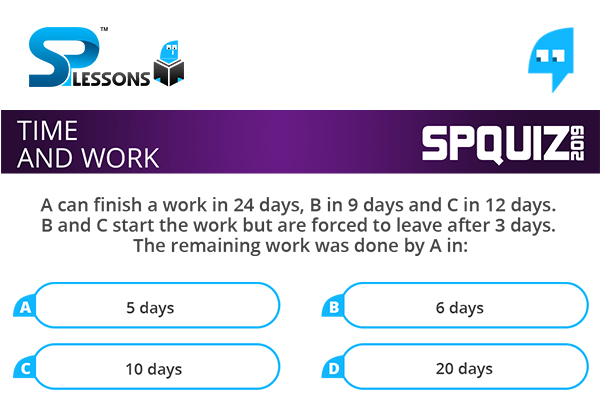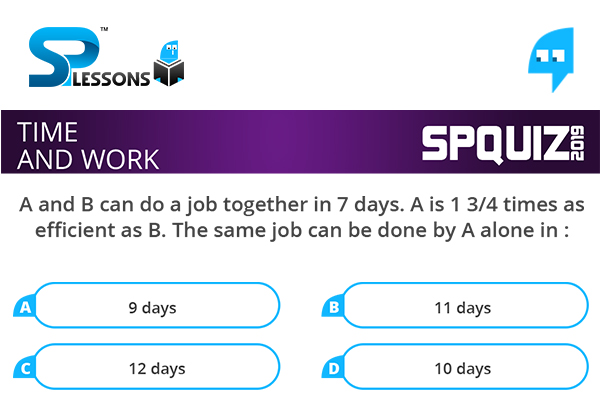 Introduction
Introduction
Time and Work is one of important topic in Quantitative Aptitude Section. In Time and Work – Quiz 5 article candidates can find questions with an answer. By solving this questions candidates can improve and maintain, speed, and accuracy in the exams. Time and Work – Quiz 5 questions are very useful for different exams such as IBPS PO, Clerk, SSC CGL, SBI PO, NIACL Assistant, NICL AO, IBPS SO, RRB, Railways, Civil Services etc.
 Q1
Q1
A can finish a work in 24 days, B in 9 days and C in 12 days. B and C start the work but are forced to leave after 3 days. The remaining work was done by A in:
- A. 5 days
B. 6 days
C. 10 days
D. 20 days
(B + C)'s 1 day's work = ([latex]\frac {1}{9}[/latex] + [latex]\frac {1}{12}[/latex]) = [latex]\frac {7}{36}[/latex]
Work done by B and C in 3 days = ([latex]\frac {7}{36} \times 3[/latex]) = [latex]\frac {7}{12}[/latex]
Remaining work = (1- [latex]\frac {7}{12}[/latex]) = [latex]\frac {5}{12}[/latex]
Now, [latex]\frac {1}{24}[/latex] work is done by A in 1 day.
So, [latex]\frac {7}{12}[/latex] work is done by A in ([latex]24 \times \frac {5}{12}[/latex]) = 10 days
 Q2
Q2
X can do a piece of work in 40 days. He works at it for 8 days and then Y finished it in 16 days. How long will they together take to complete the work?
- A. 13 1/3 days
B. 15 days
C. 20 days
D. 26 days
Work done by X in 8 days = ([latex]\frac{1}{40}[/latex] x 8) = [latex]\frac{1}{5}[/latex]
Remaining work = (1 - [latex]\frac{1}{5}[/latex]) = [latex]\frac{4}{5}[/latex]
Now, [latex]\frac{4}{5}[/latex] work is done by Y in 16 days.
Whole work will be done by Y in (16 x [latex]\frac{5}{4}[/latex]) = 20 days.
Therefore X's 1 day's work = [latex]\frac{1}{40}[/latex], Y's 1 day's work = [latex]\frac{1}{20}[/latex]
(X + Y)'s 1 day's work = ([latex]\frac{1}{40}[/latex] + [latex]\frac{1}{20}[/latex]) = [latex]\frac{3}{40}[/latex]
Hence, X and Y will together complete the work in ([latex]\frac{40}{3}[/latex]) = 13 [latex]\frac{1}{3}[/latex] days.
 Q3
Q3
A and B can do a job together in 7 days. A is 1 3/4 times as efficient as B. The same job can be done by A alone in :
- A. 9 days
B. 11 days
C. 12 days
D. 10 days
(A's 1 day's work) : (B's 1 day's work) = [latex]\frac{7}{4}[/latex] : 1 = 7 : 4.
Let A's and B's 1 day's work be 7x and 4x respectively.
Then, 7x + 4x = [latex]\frac{1}{7} \rightarrow[/latex] 11x =[latex]\frac{1}{7} \rightarrow[/latex] x = [latex]\frac{1}{77} [/latex]
Therefore A's 1 day's work = ([latex]\frac{1}{77} [/latex] x 7) = [latex]\frac{1}{11} [/latex] = 11 days
 Q4
Q4
A and B together can do a piece of work in 30 days. A having worked for 16 days, B finishes the remaining work alone in 44 days. In how many days shall B finish the whole work alone?
- A. 30 days
B. 40 days
C. 60 days
D. 70 days
Let A's 1 day's work = x and B's 1 day's work = y.
Then, x + y = [latex]\frac{1}{30}[/latex] and 16x + 44y = 1.
Solving these two equations, we get: x = [latex]\frac{1}{60}[/latex] and y = [latex]\frac{1}{60}[/latex]
B's 1 day's work = [latex]\frac{1}{60}[/latex]
Hence, B alone shall finish the whole work in 60 days.
 Q5
Q5
If 6 men and 8 boys can do a piece of work in 10 days while 26 men and 48 boys can do the same in 2 days, the time taken by 15 men and 20 boys in doing the same type of work will be:
- A. 4 days
B. 5 days
C. 6 days
D. 7 days
Let 1 man's 1 day's work = x and 1 boy's 1 day's work = y.
Then, 6x + 8y = [latex]\frac{1}{10}[/latex] and 26x + 48y = [latex]\frac{1}{2}[/latex]
Solving these two equations, we get : x = [latex]\frac{1}{100}[/latex]and y = [latex]\frac{1}{200}[/latex]
(15 men + 20 boy)'s 1 day's work = ([latex]\frac{15}{100}[/latex] + [latex]\frac{20}{200}[/latex]) = [latex]\frac{1}{4}[/latex]
i.e, 15 men and 20 boys can do the work in 4 days.








